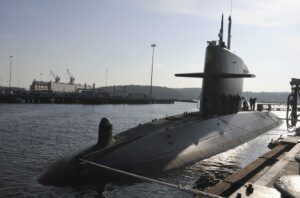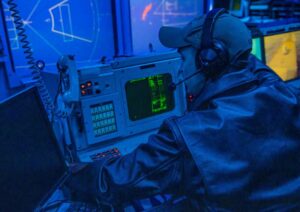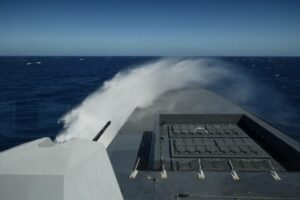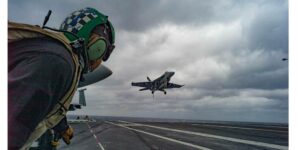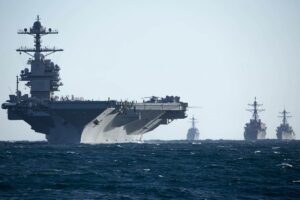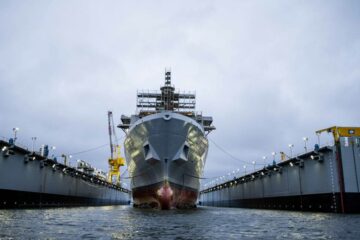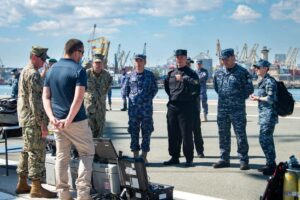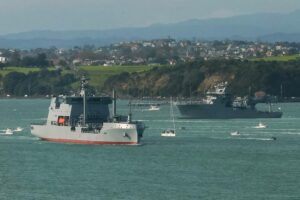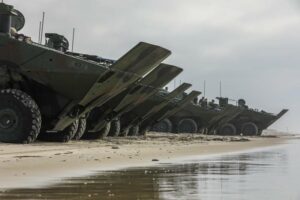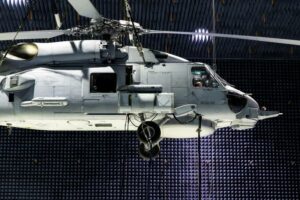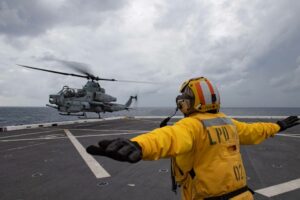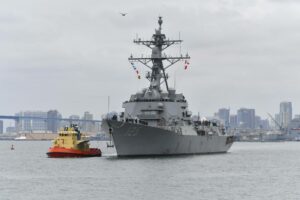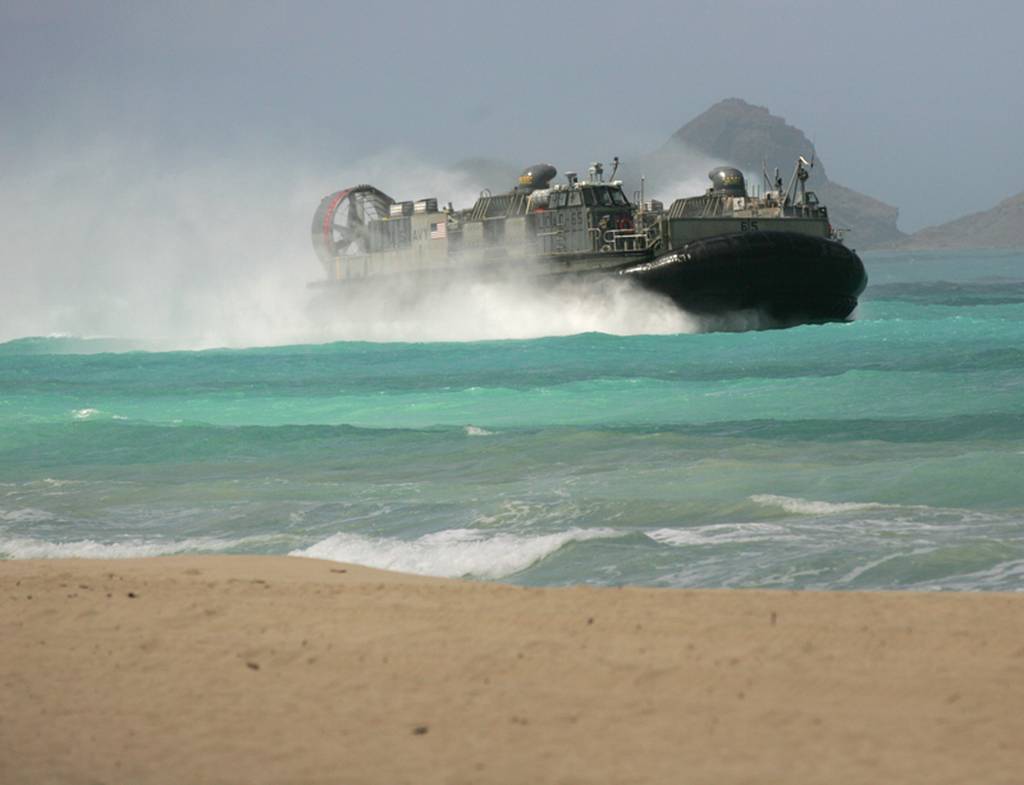
WASHINGTON — The U.S. Navy and Marine Corps should reconsider the survivability of their surface connectors, which the Corps is increasingly relying on to operate in contested waters, researchers with the think tank Rand warn in a new report.
The nonprofit research organization notes the newest connectors, the Ship to Shore Connector and the LCU 1700, were designed about a decade ago — but the Marines have overhauled the way they intend to fight in the last five years based on evolving threats.
“The landing craft utility (LCU) and landing craft air cushion (LCAC) … were not designed with survivability in mind as part of a [Stand-In Force]. The requirements for these craft were developed using past naval concepts for power projection and in a more permissive threat environment,” the report reads.
It notes the sea services previously believed they could use intelligence to avoid obstacles on their way ashore, maneuver the LCAC to keep it safe from incoming fire, and conduct ship-to-shore operations under the protection of the larger Navy-Marine force at sea.
But today, the Marine Corps is not focused on major amphibious landings, though it retains the ability to do them. Rather, the force is focused on being ever-present in contested waters.
The idea of Stand-In Forces and other recent concepts is that Marines are routinely operating in contested waters, training with partners and allies, monitoring the activities of potential adversaries, noting subtle changes in the operating area, and standing ready to tamp down any conflict that may emerge.
While this will involve traditional Marine expeditionary units aboard amphibious warships, it will also involve smaller units operating independently and moving themselves around the theater with surface and air connectors.
Many exercises to date have relied on air connectors — primarily the KC-130J transport plane and the CH-53 heavy lift helicopter — to move Marines and their goods into theater. But they’ll also need the surface connectors, especially while the Marine Corps awaits the arrival of its planned Landing Ship Medium, slated to begin detailed design and construction in fiscal 2025.
“The SSC and LCU could be the correct platforms for traditional contingency and amphibious operations and might offer some of the right capabilities for the broader [Stand-In Force]. Their survivability, however, will need to be reexamined for these contexts,” the report finds.
It calls on the Navy and Marine Corps to clarify the future roles of the LCU and SSC and then “consider ways to enhance their survivability and weigh the costs and benefits of additional investments in the current vessels.”
The report notes survivability improvements will require tradeoffs — the Navy may have to shrink its inventory of connectors if each costs more, meaning the Marines would have less ability to move around the theater — but Rand says these upgrades need to be “taken seriously.”
It also calls for a closer look at tactics, techniques and procedures to seek out areas where connector crews may be able to keep their signature low in certain scenarios to lower the risk of detection, where Navy or Marine special forces could establish overwatch or hit the beach first to take out any adversary forces, or where unmanned systems could be used to find and engage potential threats to the connectors.
Megan Eckstein is the naval warfare reporter at Defense News. She has covered military news since 2009, with a focus on U.S. Navy and Marine Corps operations, acquisition programs and budgets. She has reported from four geographic fleets and is happiest when she’s filing stories from a ship. Megan is a University of Maryland alumna.
- SEO Powered Content & PR Distribution. Get Amplified Today.
- PlatoData.Network Vertical Generative Ai. Empower Yourself. Access Here.
- PlatoAiStream. Web3 Intelligence. Knowledge Amplified. Access Here.
- PlatoESG. Carbon, CleanTech, Energy, Environment, Solar, Waste Management. Access Here.
- PlatoHealth. Biotech and Clinical Trials Intelligence. Access Here.
- Source: https://www.defensenews.com/naval/2023/10/04/rand-calls-for-reexamination-of-surface-connectors-survivability/
- :has
- :is
- :not
- :where
- 11
- 2023
- 2025
- 26
- 50
- 70
- a
- ability
- Able
- About
- acquisition
- activities
- Additional
- ago
- AIR
- also
- and
- any
- ARE
- AREA
- areas
- around
- arrival
- AS
- assigned
- At
- avoid
- based
- BE
- Beach
- begin
- being
- believed
- benefits
- broader
- Budgets
- but
- Calls
- capabilities
- certain
- Changes
- closer
- concepts
- Conduct
- conflict
- construction
- contexts
- correct
- Costs
- could
- covered
- craft
- Current
- Date
- decade
- deck
- Defense
- Design
- designed
- detailed
- Detection
- developed
- do
- Dock
- down
- each
- emerge
- engage
- enhance
- Environment
- especially
- establish
- evolving
- fight
- Filing
- Find
- finds
- Fire
- First
- Fiscal
- five
- Focus
- focused
- For
- Force
- Forces
- four
- from
- future
- geographic
- goods
- Hall
- Have
- heavy
- helicopter
- Hit
- However
- HTML
- HTTPS
- idea
- if
- images
- improvements
- in
- Incoming
- increasingly
- independently
- Intelligence
- intend
- into
- inventory
- Investments
- involve
- IT
- ITS
- jpg
- Keep
- landing
- larger
- Last
- less
- Look
- Low
- lower
- major
- Marine
- Maryland
- May..
- meaning
- medium
- Megan
- might
- Military
- mind
- monitoring
- more
- move
- moving
- Need
- New
- Newest
- news
- Nonprofit
- Notes
- noting
- obstacles
- of
- offer
- on
- operate
- operating
- Operations
- or
- organization
- Other
- out
- Overwatch
- part
- partners
- past
- plane
- planned
- Platforms
- plato
- Plato Data Intelligence
- PlatoData
- potential
- power
- previously
- primarily
- procedures
- Programs
- Projection
- protection
- rand
- rather
- ready
- recent
- reconsider
- relying
- report
- Reported
- reporter
- Requirements
- research
- retains
- right
- Risk
- roles
- routinely
- s
- safe
- says
- scenarios
- SEA
- Seek
- seriously
- Services
- she
- should
- signature
- since
- smaller
- some
- special
- Stories
- Surface
- Systems
- tactics
- Take
- TAMP
- tank
- techniques
- that
- The
- The Future
- Theater
- their
- Them
- themselves
- then
- These
- they
- think
- think tank
- this
- though?
- threat
- threats
- to
- today
- toward
- traditional
- Training
- transport
- u.s.
- U.S. Navy
- under
- unit
- units
- university
- University of Maryland
- upgrades
- use
- used
- using
- utility
- vessels
- Waters
- Way..
- ways
- weigh
- WELL
- were
- when
- which
- while
- will
- with
- would
- years
- zephyrnet

